Coral honeysuckle (Lonicera sempervirens), also called trumpet honeysuckle, is a vine native to all parts of Florida. Let’s talk about its origins, growing conditions, and ecological significance.
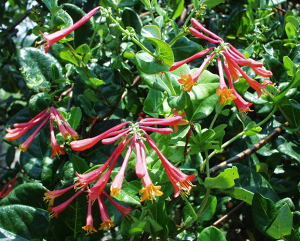
Origins of the Coral Honeysuckle
The coral honeysuckle is indigenous to the eastern United States, thriving in various habitats from woodlands to open fields. This climbing vine is a member of the honeysuckle family. in Central and South Florida, this vine is evergreen, but may drop its leaves in the cooler areas of North Florida. Historically, it has been appreciated for its ornamental value and its role in local ecosystems. Besides the beauty of the plant, Native American tribes valued flowers for use in traditional medicines.
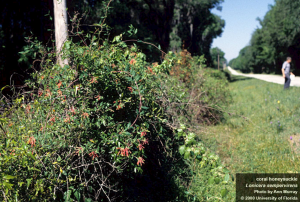
Growing Conditions and Characteristics
Coral honeysuckle thrives in well-drained soils and can adapt to a range of conditions, including full sun to partial shade. It is cold hardy and well-suited for USDA Hardiness Zones 4-10. This perennial vine can be found in habitats like deciduous forests, thickets, and along fences. The coral honeysuckle is another Florida-Friendly Landscaping ™ approved plant great for both upright spaces and as a broad groundcover.
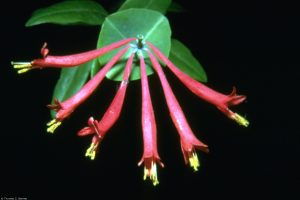
Like most vines, coral honeysuckle will climb and twine around structures and other plants, which makes it perfect to grow trellises and fences. It can grow to heights of up to 15 feet, so plan ahead when planting! Coral honeysuckle has glossy, dark green leaves and clusters of vibrant, tubular flowers that attract bees, butterflies, and hummingbirds in the spring and early summer before turning into berries. The varying hues bright red to orange fruits also attract birds like cardinals hunting for a treat.
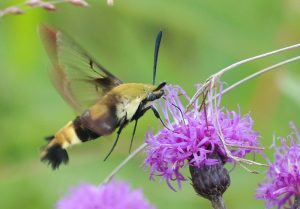
The Threat of Invasive Species
While non-native-exotic plants may contribute positively to local ecosystems, invasive-exotic species pose significant threats by out-competing native flora and disrupting ecological balance. This results in plant and animal species struggling to survive. In many regions, invasive-exotic honeysuckles (like Japanese honeysuckle) and other non-native species threaten the survival of native plants.
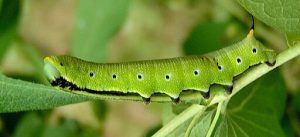
Learn more about invasive exotic plants here: https://livinggreen.ifas.ufl.edu/topics/landscaping/invasive-exotic-plants/.
Why Plant Native Species?
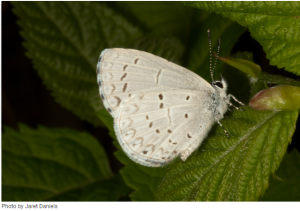
Native plants like the coral honeysuckle require minimal maintenance once established, needing little supplemental irrigation and low fertilizer inputs. They also attract beneficial wildlife, serving as important food sources for hummingbirds and various insects. The plant also is a host for the Larval host for Spring Azure (Celastrina ladon) and Snowberry Clearwing (Hemaris diffinis) butterflies. By incorporating native plants, you support local biodiversity and help create sustainable landscapes and serves as a great garden alternative to the invasive-exotic Japanese honeysuckle (Lonicera japonica).

Have a question?
If you have any questions about gardening in Central Florida, please contact UF/IFAS Extension Pasco County at 352-518-0156. For more information on UF/IFAS Extension Pasco County Community Gardens, and how you can join one, visit http://sfyl.ifas.ufl.edu/pasco/. Supervising Agent: Dr. Whitney Elmore.
Follow us!
We have several ways to connect.
Other Blogs in the Series
- Exploring Florida’s Native Gems: Carolina Jessamine
- Exploring Florida’s Native Gems: Chickasaw Plum
- Florida’s Native Gems: The Coontie
More resources
 2
2
